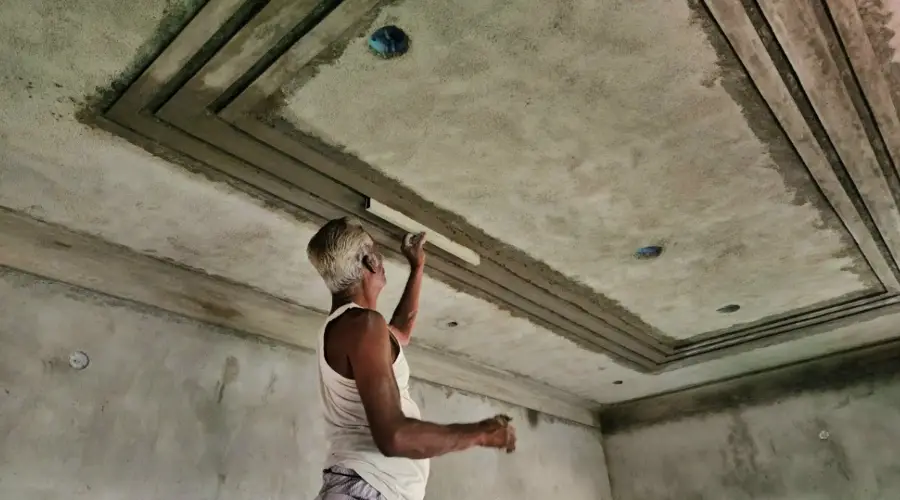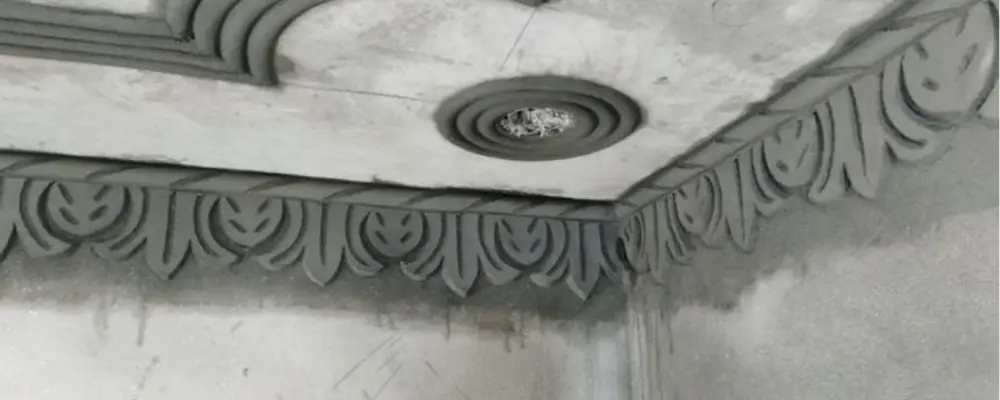Cement ceiling decoration is a thoughtful idea to improve your home’s look. Introducing visually striking designs gives more depth and dimension to the space. You might be tired and have tired of various decorative ideas; however, the cement ceiling designs are exceptional.
It makes your space stylish but not ordinary. It doesn’t matter whether you are constructing a new home or renovating the existing one; give it a try with cement in the ceiling. For sure, the results will be quite surprising. In this article, you’ll get to understand the creation process of cement ceiling corners. Read to know the key materials required, essential tools, and a step-by-step guide.
Key Materials Needed for Cement Ceiling Corner Design
These are the key materials involved in the creation of cement ceiling design. Based on the specific design, the material requirements may vary.
Cement: Cement is the fundamental material used to design the structure and texture of the corner. It is a relatively cost-effective material that helps create a wide range of finishes from smooth to textured.
Sand: Sand is a granular material that improves the workability of the cement mixture, making it easier to apply and shape. It contributes to the enhanced durability and strength of the cement-based material.
Water: Water is a necessary base for the hydration process of cement. When mixing the cement and sand with water, they eventually harden into a solid mass.
Tools: These are the tools required for shaping and finishing the corner, such as a putty knife, trowel, level, mixing paddle, edging tool, sandpaper, grinder, and stencil.
POP (Plaster of Paris): Plaster of Paris is essential to creating intricate mouldings and designs. It is a key component in achieving a unique style and elevating the ambiance to the next level.
Metal Profiles: These are primarily used to create frameworks when working on false ceilings and, in addition, to support heavy elements.
Paint: Designing a ceiling corner is fine, but providing appropriate paint colour makes it more pleasant and eye-catching.
Step-by-Step Guide to Designing Cement Ceiling Corners
Designing a cement ceiling corner provides instant aesthetic appeal to your room. Whether you are aiming to create a minimalist or rustic look, these steps will take you through the process:
Measure and Mark the Area
Identify the corner that you aim to apply the cement. Use a measuring tape to exactly determine the length and width of the total area. For exact identification, you can mark with a pencil to achieve the desired shape and size of the corner.
Prepare the Cement Mix
It is recommended to opt for the high-quality cement suitable for decoration in interior applications. The combination of cement and sand mixture is crucial; the advisable ratio is 1:2 or 1:3. Then gradually add water to the dry mixture until you achieve the workable consistency.
Create a Framework or Moulding

Creating a framework or moulding is a significant process. If you decide to go with intricate designs, it is suggested that you use the pre-made mouldings as the best option. In contrast, for a customised look or design, plan and create your own mouldings using metal or wood.
Apply the Cement
Use the dipping technique to apply the cement mixture on the corner and ensure even coverage over the ceiling. If any gaps or voids exist, cover them with additional cement mixtures.
Smooth and Shape the Corners
You can use a trowel to smooth the corners and create desired textures. Edging tools are another good option to create sharp and decorative patterns that align with your interior applications. Finally, use a level tool to ensure the surface of the ceiling is perfectly leveled.
Allow the Cement to Dry
Cement drying will take several days to achieve its complete strength and stability. Avoid touching or disturbing it during this curing time, which might cause damages to the corners.
Finish and Polish
Once it is completely dried, sand the surface to remove the imperfections that are present. To elevate the appearance to the next level, paint the corners in alignment with your infrastructure colour scheme.
Tips for Maintaining Cement Ceiling Corners
To extend the durability of cement ceiling corners requires proper maintenance and care. Here are some of the significant tips given that you should follow as a priority:
- It is advisable to inspect the corners periodically and identify whether they are subjected to cracks, chips, or discolouration. Earlier signs can be easily handled and don’t cost much in maintenance.
- Remove accumulated dust or dirt from the corners regularly using a feather duster or a soft cloth. If you have found any stubborn stains, use mild detergents that are harmless to the texture and paint colour.
- Repair the small damages like cracks or chips at the earlier stages. Similarly, if the paint colour is fading or chipping, repaint the corners to retrieve its appearance.
- Reseal the edges and corners periodically to avoid the formation of moisture and prevent wear and tear.
Common Mistakes to Avoid When Designing Cement Ceiling Corners
Cement ceiling corners add a unique touch to your space, but certain mistakes can harm the look and durability. Here are those:
- The incorrect ratio of mixture, like cement, sand, and water, can lead to imperfect and brittle corners. Ensure that you use high-quality materials at the appropriate consistency to achieve the desired strength and durability.
- Neglecting the dirty surface can hinder the bond strength of the cement. For proper adhesion, the ceiling should be properly cleaned of any dust or dirt.
- Poor application techniques like adding too much water, inconsistent application, and insufficient drying time can compromise the surface strength and cause cracking or chipping.
- Not sanding the surface can leave imperfections and roughness on the corners. When you ignore sealing or sanding processes, the surface is highly susceptible to moisture damage.
Final Wordings
Cement ceiling designs provide a wide range of options to transform your ambiance. It doesn’t matter whether you aim for classical mouldings or floral patterns; they match your taste. However, proper pre-planning and quality materials streamline the whole process and achieve the desired look.
FAQs
When designing the ceiling corners, a 1:4 ratio of cement-sand mix is ideal. If you are particularly expecting high-strength or water-resistant corners, you can directly consult the professionals for product-specific instructions.
Yes, you can plan and design ceiling corners without the assistance of professionals. However, it requires strong attention to detail, patience, and some DIY skills to handle quality tools.
For complete drying, it may take 7 to 10 days. But still, it depends on various factors, including the thickness of the cement layer, ventilation, humidity, and temperature.

